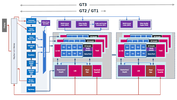Intel HD Graphics 510 vs Intel HD Graphics (Broadwell) vs Intel Iris Pro Graphics 580
Intel HD Graphics 510
► remove from comparison
Die Intel HD Graphics 510 (GT1) ist eine Prozessorgrafikkarte der im September 2015 vorgestellten Skylake-Generation (z.B. Pentium 4405U). Zwar glänzt die GPU mit einer niedrigen Leistungsaufnahme, allerdings siedelt sich die Performance nur im Low-End-Segment an und ist für neuere Spiele selten ausreichend. Als sogenannte GT1-Ausbaustufe der Skylake-GPU verfügt die HD Graphics 510 über 12 Execution Units (EUs), die je nach Modell mit bis zu 950 MHz takten.
Mangels eigenem Grafikspeicher oder eDRAM-Cache greift die HD Graphics 510 über das Interface des Prozessors auf den System-RAM zu (2x 64 Bit DDR3L-1600/LPDDR3-1866).
Performance
Die exakte Leistung der HD Graphics 510 dürfte sich knapp unterhalb der älteren HD Graphics 4400 ansiedeln, sodass aktuelle Spiele (Stand 2015) nur in wenigen Fällen und in niedrigsten Einstellungen flüssig dargestellt werden.
Features
Der überarbeitete Videodecoder decodiert nun auch H.265-/HEVC-Videos vollständig in Hardware und arbeitet dadurch deutlich effizienter als bislang. Die Bildausgabe erfolgt über DP 1.2/eDP 1.3 (max. 3.840 x 2.160 @ 60 Hz), wohingegen HDMI nur in der älteren Version 1.4a angeboten wird. Ein HDMI-2.0-Anschluss kann aber mittels Konverter von DisplayPort ergänzt werden. Maximal lassen sich drei Displays parallel angesteuern.
Leistungsaufnahme
Die TDP des gesamten Chips liegt standardmäßig bei 15 Watt, sodass die GPU vor allem in Ultrabooks oder oder schlanken Notebooks zu finden ist. Teils kann die TDP auch auf 10 Watt abgesenkt werden, wodurch allerdings die Performance sinkt.
Intel HD Graphics (Broadwell)
► remove from comparison
Die Intel HD Graphics (Broadwell) (GT1) ist eine Prozessorgrafikkarte in den CPUs der Broadwell-Generation. Die GPU wird in einigen Pentium- und Celeron-Modellen der Serie verbaut und bietet 12 EUs (Execution Units bzw. Ausführungseinheiten). Die maximale Turbo-Taktrate und damit auch die Performance kann sich von Modell zu Modell leicht unterscheiden, insgesamt siedelt sich die Grafikkarte aber nur im Low-End-Segment an und ist für neuere Spiele kaum ausreichend.
Architektur und Features
Broadwell integriert eine Grafikeinheit auf Basis der Intel-Gen8-Architektur, die gegenüber dem Vorgänger Intel Gen7.5 (Haswell) in verschiedenen Punkten weiterentwickelt wurde. So hat Intel unter anderem die "Subslice" genannten Shader-Arrays umorganisiert, die bei diesem Modell nun jeweils 6 Execution Units (EUs) beinhalten. Zwei Subslices bilden wiederum einen Slice mit insgesamt 12 EUs. Hinzu kommen größere L1-Caches und Verbesserungen im Front-End, die die Leistung zusätzlich steigern sollen.
Die HD Graphics (Broadwell) repräsentiert die kleinste, auch "GT1" bezeichnete Ausbaustufe mit einem Slice und 12 EUs. Daneben existieren auch schnellere Varianten wie die GT2 (24 EUs) sowie die GT3/GT3e (48 EUs) ohne/mit zusätzlichem eDRAM-Cache.
Alle Broadwell-GPUs unterstützen OpenCL 2.0 sowie DirectX 12 (FL 11_1). Zudem kann der Videodecoder nun auch den H.265-Codec verarbeiten, greift dafür allerdings nur teilweise auf besonders sparsame Fixed-Function-Einheiten zurück. Die Bildausgabe erfolgt über DP 1.2/eDP 1.3 (max. 3.840 x 2.160 @ 60 Hz) oder HDMI 1.4a (max. 3.840 x 2.160 @ 24 Hz), HDMI 2.0 steht dagegen nicht zur Verfügung. Es können maximal drei Displays parallel angesteuert werden.
Performance
Obwohl der maximale GPU-Takt etwas niedriger ausfällt, dürfte die HD Graphics (Broadwell) die ältere HD Graphics (Haswell) klar übertrumpfen und etwa das Niveau der HD Graphics 4000 erreichen. Nur sehr wenige aktuelle Spiele wie das anspruchslose Dota 2 lassen sich in niedrigen Einstellungen flüssig darstellen.
Leistungsaufnahme
Die bislang vorgestellten Celeron- und Pentium-Prozessoren gehören ausschließlich der sparsamen 15-Watt-Klasse an, später dürften auch weitere Dual-Core-Modelle mit 37 Watt TDP folgen. Abhängig davon ist die HD Graphics (Broadwell) sowohl in kleinen Subnotebooks als auch deutlich größeren Geräten zu finden.
Intel Iris Pro Graphics 580
► remove from comparisonDie Intel Iris Pro Graphics 580 (GT4e) ist eine Prozessorgrafikkarte der im Sommer 2015 vorgestellten Skylake-Generation. Als Nachfolger der Iris Pro Graphics 6200 (Broadwell) ist die Iris Pro 580 dabei in ausgewählten Quad-Core-Modellen zu finden und besitzt einen dedizierten eDRAM-Cache mit 128 MB Kapazität. Die sogenannte GT4e-Ausbaustufe der Skylake-GPU verfügt zudem über 72 Execution Units (EUs) und damit deutlich mehr Rechenleistung als die GT2- (24 EUs) und GT3e-Ausbaustufen (48 EUs). Neben dem eDRAM-Cache kann die Iris 580 auch über das Interface des Prozessors auf den Hauptspeicher zugreifen (2x 64 Bit DDR3L-1600/DDR4-2133).
Im Unterschied zur Profi-Variante Iris Pro Graphics P580 ist die Iris 580 nicht in Xeon-Modellen, sondern herkömmlichen Quad-Core-CPUs der H-Serie zu finden, weist ansonsten aber keine bedeutsamen technischen Abweichungen auf.
Performance
Die exakte Leistung der Iris Pro Graphics 580 hängt unter anderem vom jeweiligen CPU-Modell sowie der Speicherbestückung ab. Im Optimalfall übertrifft die Performance knapp eine dedizierte GeForce 940M mit GDDR5-Speicher (GM108-Chip) und liegt damit in der Mittelklasse mobiler Grafikchips des Jahres 2015/2016. Aktuelle Spiele können zumeist in mittleren Einstellungen flüssig dargestellt werden.
Features
Die überarbeitete Videoeinheit decodiert nun auch H.265-/HEVC-Videos vollständig in Hardware und arbeitet dadurch deutlich effizienter als bislang. Die Bildausgabe erfolgt über DP 1.2/eDP 1.3 (max. 3.840 x 2.160 @ 60 Hz), wohingegen HDMI nur in der älteren Version 1.4 angeboten wird. Ein HDMI-2.0-Anschluss kann aber mittels Konverter von DisplayPort ergänzt werden. Maximal lassen sich drei Displays parallel angesteuern.
Leistungsaufnahme
Die Iris Pro Graphics 580 wird zunächst ausschließlich in Prozessoren der 45-Watt-Klasse verbaut und ist damit vorrangig in größeren Notebooks zu finden.
| Intel HD Graphics 510 | Intel HD Graphics (Broadwell) | Intel Iris Pro Graphics 580 | ||||||||||||||||||||||||||||||||||||||||||||||||||||||||||||||||||||||||||||||||||||||||||||||||||||||||||||||||||||||||||||||||||||||||||||||||||||||||||
| Gen. 9 Serie |
|
|
| |||||||||||||||||||||||||||||||||||||||||||||||||||||||||||||||||||||||||||||||||||||||||||||||||||||||||||||||||||||||||||||||||||||||||||||||||||||||||
| Codename | Skylake GT1 | Broadwell GT1 | Skylake GT4e | |||||||||||||||||||||||||||||||||||||||||||||||||||||||||||||||||||||||||||||||||||||||||||||||||||||||||||||||||||||||||||||||||||||||||||||||||||||||||
| Architektur | Gen. 9 Skylake | Gen. 8 Broadwell | Gen. 9 Skylake | |||||||||||||||||||||||||||||||||||||||||||||||||||||||||||||||||||||||||||||||||||||||||||||||||||||||||||||||||||||||||||||||||||||||||||||||||||||||||
| Pipelines | 12 - unified | 12 - unified | 72 - unified | |||||||||||||||||||||||||||||||||||||||||||||||||||||||||||||||||||||||||||||||||||||||||||||||||||||||||||||||||||||||||||||||||||||||||||||||||||||||||
| Kerntakt | 300 - 950 (Boost) MHz | 100 - 850 (Boost) MHz | 350 - 1050 (Boost) MHz | |||||||||||||||||||||||||||||||||||||||||||||||||||||||||||||||||||||||||||||||||||||||||||||||||||||||||||||||||||||||||||||||||||||||||||||||||||||||||
| Speicherbandbreite | 64/128 Bit | 64/128 Bit | eDRAM + 64/128 Bit | |||||||||||||||||||||||||||||||||||||||||||||||||||||||||||||||||||||||||||||||||||||||||||||||||||||||||||||||||||||||||||||||||||||||||||||||||||||||||
| Speichertyp | DDR3/DDR4 | eDRAM | ||||||||||||||||||||||||||||||||||||||||||||||||||||||||||||||||||||||||||||||||||||||||||||||||||||||||||||||||||||||||||||||||||||||||||||||||||||||||||
| Shared Memory | ja | ja | ja | |||||||||||||||||||||||||||||||||||||||||||||||||||||||||||||||||||||||||||||||||||||||||||||||||||||||||||||||||||||||||||||||||||||||||||||||||||||||||
| API | DirectX 12_1, OpenGL 4.4 | DirectX 12 (FL 11_1), OpenGL 4.3 | DirectX 12_1, OpenGL 4.4 | |||||||||||||||||||||||||||||||||||||||||||||||||||||||||||||||||||||||||||||||||||||||||||||||||||||||||||||||||||||||||||||||||||||||||||||||||||||||||
| Herstellungsprozess | 14 nm | 14 nm | 14 nm | |||||||||||||||||||||||||||||||||||||||||||||||||||||||||||||||||||||||||||||||||||||||||||||||||||||||||||||||||||||||||||||||||||||||||||||||||||||||||
| Features | QuickSync | QuickSync | QuickSync | |||||||||||||||||||||||||||||||||||||||||||||||||||||||||||||||||||||||||||||||||||||||||||||||||||||||||||||||||||||||||||||||||||||||||||||||||||||||||
| Erscheinungsdatum | 01.09.2015 | 05.01.2015 | 24.01.2016 | |||||||||||||||||||||||||||||||||||||||||||||||||||||||||||||||||||||||||||||||||||||||||||||||||||||||||||||||||||||||||||||||||||||||||||||||||||||||||
| Max. Speichergröße | 128 MB |
|
|
| ||||||||||||||||||||||||||||||||||||||||||||||||||||||||||||||||
Benchmarks
3DM Vant. Perf. total + Intel HD Graphics 510
Cinebench R15 OpenGL 64 Bit + Intel HD Graphics 510
GFXBench T-Rex HD Offscreen C24Z16 + Intel HD Graphics 510
Average Benchmarks Intel HD Graphics 510 → 100% n=13
Average Benchmarks Intel HD Graphics (Broadwell) → 70% n=13
Average Benchmarks Intel Iris Pro Graphics 580 → 300% n=13
* Smaller numbers mean a higher performance
1 This benchmark is not used for the average calculation
Spiele-Benchmarks
Die folgenden Benchmarks basieren auf unseren Spieletests mit Testnotebooks. Die Performance dieser Grafikkarte bei den gelisteten Spielen ist abhängig von der verwendeten CPU, Speicherausstattung, Treiber und auch Betriebssystem. Dadurch müssen die untenstehenden Werte nicht repräsentativ sein. Detaillierte Informationen über das verwendete System sehen Sie nach einem Klick auf den fps-Wert.

Resident Evil 7
2017
Titanfall 2
2016
Farming Simulator 17
2016
Civilization VI
2016
Overwatch
2016
The Division
2016
Rainbow Six Siege
2015
FIFA 16
2015
World of Warships
2015
Metal Gear Solid V
2015
Dota 2 Reborn
2015
Dirt Rally
2015
Battlefield Hardline
2015
F1 2014
2014
Sims 4
2014
GRID: Autosport
2014
Thief
2014
Battlefield 4
2013
Metro: Last Light
2013
BioShock Infinite
2013
Tomb Raider
2013
Hitman: Absolution
2012
Guild Wars 2
2012
Counter-Strike: GO
2012
Sleeping Dogs
2012
Diablo III
2012Average Gaming Intel HD Graphics 510 → 100%
Average Gaming 30-70 fps → 100%
Average Gaming Intel HD Graphics (Broadwell) → 65%
Average Gaming 30-70 fps → 50%
Average Gaming Intel Iris Pro Graphics 580 → 215%
Average Gaming 30-70 fps → 202%
| Intel HD Graphics 510 | low | med. | high | ultra | QHD | 4K |
|---|---|---|---|---|---|---|
| Resident Evil 7 | 18.3 | |||||
| Titanfall 2 | 19.9 | 15.4 | ||||
| Farming Simulator 17 | 70.6 | 41.3 | ||||
| Civilization VI | 24.5 | 9.4 | ||||
| The Division | 13.4 | 7.7 | ||||
| Rise of the Tomb Raider | 11.1 | 7 | ||||
| Rainbow Six Siege | 25 | 15.9 | ||||
| Anno 2205 | 19.9 | 11 | ||||
| World of Warships | 48.7 | 29.2 | ||||
| Metal Gear Solid V | 38.9 | 25.2 | ||||
| Dota 2 Reborn | 66.2 | 41.8 | ||||
| Dirt Rally | 110.4 | 19.3 | ||||
| GTA V | 30.9 | 26.8 | ||||
| Battlefield Hardline | 31.5 | 22.2 | ||||
| F1 2014 | 72 | 47 | ||||
| Sims 4 | 173.7 | 32.2 | ||||
| GRID: Autosport | 135.5 | 32.8 | ||||
| Battlefield 4 | 33.4 | 22.5 | 15.9 | |||
| BioShock Infinite | 39 | 20.1 | 17.7 | |||
| Tomb Raider | 52.7 | 23.9 | 16.2 | |||
| < 30 fps < 60 fps < 120 fps ≥ 120 fps | 7 7 4 2 | 14 5 | 3 | | | |
| Intel Iris Pro Graphics 580 | low | med. | high | ultra | QHD | 4K |
|---|---|---|---|---|---|---|
| Overwatch | 60.5 | 53.3 | 42.9 | 23.1 | ||
| Doom | ||||||
| Rise of the Tomb Raider | 30.2 | 18.2 | 12.2 | 8.9 | ||
| Fallout 4 | ||||||
| Metal Gear Solid V | 59.9 | 58.6 | 23 | 14.9 | ||
| Dota 2 Reborn | 59.8 | 37.2 | 15.3 | 14 | ||
| Batman: Arkham Knight | ||||||
| Thief | 43.8 | 30.1 | 25 | 12.4 | ||
| Metro: Last Light | 63.7 | 50.8 | 28.5 | 14.3 | ||
| BioShock Infinite | 101.3 | 57.9 | 51 | 14.9 | ||
| StarCraft II: Heart of the Swarm | 380.6 | 127.1 | 73.6 | 36.2 | ||
| Guild Wars 2 | 115.8 | 38.7 | 16.7 | |||
| Sleeping Dogs | 107.2 | 81.2 | 37.3 | 8.8 | ||
| < 30 fps < 60 fps < 120 fps ≥ 120 fps | 4 5 1 | 1 6 1 1 | 5 4 1 | 9 1 | | |
| Intel HD Graphics (Broadwell) | low | med. | high | ultra | QHD | 4K |
|---|---|---|---|---|---|---|
| Star Wars Battlefront | 15.3 | 8.5 | ||||
| FIFA 16 | 38.1 | 20.6 | ||||
| World of Warships | 29 | 20.8 | ||||
| Dirt Rally | 50 | 13.5 | ||||
| Battlefield Hardline | 23.9 | 16.4 | ||||
| Dragon Age: Inquisition | 13.9 | 9.4 | ||||
| F1 2014 | 34 | 24 | ||||
| Sims 4 | 113.6 | 26.3 | ||||
| GRID: Autosport | 57.6 | 22.6 | ||||
| Metro: Last Light | 13.7 | 10.7 | 7 | |||
| BioShock Infinite | 25.3 | 14.1 | 11.7 | |||
| Tomb Raider | 34.7 | 17.7 | 11.7 | |||
| Hitman: Absolution | 15.6 | 11.4 | 5.3 | |||
| Counter-Strike: GO | 43.7 | 31.5 | 23.9 | |||
| Diablo III | 38.4 | 24.9 | 19.7 | |||
| < 30 fps < 60 fps < 120 fps ≥ 120 fps | 7 7 1 | 13 1 | 7 | | | |
Eine Liste mit weiteren Spielen und allen Grafikkarten finden Sie auf unserer Seite: Welches Spiel ist mit welcher Grafikkarte spielbar?




















